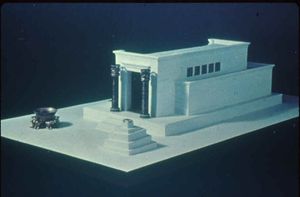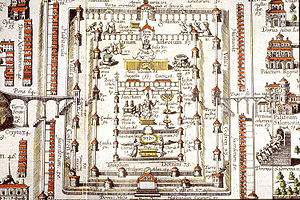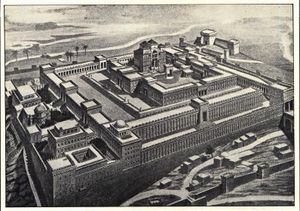Solomon's Temple

Solomon's Temple, the first permanently built temple in Israel, was commissioned by Solomon and built on the Temple Mount Moriah in Jerusalem with the help of Phoenician builders, who according to the Temple Legend were led by Hiram Abiff. Construction began in 957 BC and was consecrated in 951 BC, so it took seven years to build (1 Kings 6:38). At the beginning of the Babylonian captivity (586/87 BC), the Temple was destroyed by the Babylonians under the leadership of Nebuchadnezzar II - presumably by deliberate burning.
Freemasonry has preserved a shadow of the Old Testament esotericism that found its symbolic expression in Solomon's temple building:
„That which was the secrets of Solomon's Temple has, with a few exceptions, been almost completely absorbed into all the Masonic and other secret societies of the present time.“ (Lit.:GA 187, p. 37f)
The Construction of the Temple



Solomon's Temple was built of stone, had a length of 60 cubits[1], a width of 20 cubits and a height of 30 cubits. On three sides it was surrounded by rooms running around the outside, which, in three storeys one above the other, served to store the treasures and utensils of the temple. This expresses the physical and spiritual threefold structure of the human being and also sheds light on the threefold structure of the social organism demanded by Rudolf Steiner for our time. In particular, it refers to the three lower members of the human being, the physical body, the etheric body and the astral body, which are transformed by the I, which can only be encountered in the veiled Holy of Holies, into the higher spiritual members (Manas, Buddhi and Atma), which together are symbolised as the so-called Golden Triangle and together form the higher self of man.
In front of the entrance was the 10 cubit deep vestibule, in front of which stood two bronze columns, Jachin and Boaz ("firmness and strength"), which however had no constructive function, but flanked the entrance as meaningful symbols. As was customary in antiquity, the entrance was in the east, the Holy of Holies in the west.
A central theme of the temple legend is the casting of the Molten Sea (1 Kings 7:23 LUT), a bronze basin that rested in front of the temple on twelve bronze oxen symbolising the powers of the zodiac.
The interior of the Temple consisted of a 40 cubit front room, the Holy Place, containing the golden candlesticks, the table of showbread and the altar of incense, and a 20 cubit square back room separated from it by a curtain, the Holy of Holies, containing the Ark of the Covenant and two large Cherubim. The walls of both rooms and the floor and ceiling of the Holy of Holies (Adyton) were panelled with woodwork and lined with gold. The large main altar for the burnt offerings stood in the courtyard, in front of the entrance to the temple proper. In the 1st Book of Kings, the construction of the temple is described thus:
„1 In the four hundred and eightieth year after the people of Israel came out of the land of Egypt, in the fourth year of Solomon’s reign over Israel, in the month of Ziv, which is the second month, he began to build the house of the Lord. 2 The house that King Solomon built for the Lord was sixty cubits long, twenty cubits wide, and thirty cubits high. 3 The vestibule in front of the nave of the house was twenty cubits long, equal to the width of the house, and ten cubits deep in front of the house. 4 And he made for the house windows with recessed frames. 5 He also built a structure against the wall of the house, running around the walls of the house, both the nave and the inner sanctuary. And he made side chambers all around. 6 The lowest story was five cubits broad, the middle one was six cubits broad, and the third was seven cubits broad. For around the outside of the house he made offsets on the wall in order that the supporting beams should not be inserted into the walls of the house. 7 When the house was built, it was with stone prepared at the quarry, so that neither hammer nor axe nor any tool of iron was heard in the house while it was being built. 8 The entrance for the lowest story was on the south side of the house, and one went up by stairs to the middle story, and from the middle story to the third. 9 So he built the house and finished it, and he made the ceiling of the house of beams and planks of cedar. 10 He built the structure against the whole house, five cubits high, and it was joined to the house with timbers of cedar. 11 Now the word of the Lord came to Solomon, 12 “Concerning this house that you are building, if you will walk in my statutes and obey my rules and keep all my commandments and walk in them, then I will establish my word with you, which I spoke to David your father. 13 And I will dwell among the children of Israel and will not forsake my people Israel.” 14 So Solomon built the house and finished it. 15 He lined the walls of the house on the inside with boards of cedar. From the floor of the house to the walls of the ceiling, he covered them on the inside with wood, and he covered the floor of the house with boards of cypress. 16 He built twenty cubits of the rear of the house with boards of cedar from the floor to the walls, and he built this within as an inner sanctuary, as the Most Holy Place. 17 The house, that is, the nave in front of the inner sanctuary, was forty cubits long. 18 The cedar within the house was carved in the form of gourds and open flowers. All was cedar; no stone was seen. 19 The inner sanctuary he prepared in the innermost part of the house, to set there the ark of the covenant of the Lord. 20 The inner sanctuary was twenty cubits long, twenty cubits wide, and twenty cubits high, and he overlaid it with pure gold. He also overlaid an altar of cedar. 21 And Solomon overlaid the inside of the house with pure gold, and he drew chains of gold across, in front of the inner sanctuary, and overlaid it with gold. 22 And he overlaid the whole house with gold, until all the house was finished. Also the whole altar that belonged to the inner sanctuary he overlaid with gold. 23 In the inner sanctuary he made two cherubim of olivewood, each ten cubits high. 24 Five cubits was the length of one wing of the cherub, and five cubits the length of the other wing of the cherub; it was ten cubits from the tip of one wing to the tip of the other. 25 The other cherub also measured ten cubits; both cherubim had the same measure and the same form. 26 The height of one cherub was ten cubits, and so was that of the other cherub. 27 He put the cherubim in the innermost part of the house. And the wings of the cherubim were spread out so that a wing of one touched the one wall, and a wing of the other cherub touched the other wall; their other wings touched each other in the middle of the house. 28 And he overlaid the cherubim with gold. 29 Around all the walls of the house he carved engraved figures of cherubim and palm trees and open flowers, in the inner and outer rooms. 30 The floor of the house he overlaid with gold in the inner and outer rooms. 31 For the entrance to the inner sanctuary he made doors of olivewood; the lintel and the doorposts were five-sided. 32 He covered the two doors of olivewood with carvings of cherubim, palm trees, and open flowers. He overlaid them with gold and spread gold on the cherubim and on the palm trees. 33 So also he made for the entrance to the nave doorposts of olivewood, in the form of a square, 34 and two doors of cypress wood. The two leaves of the one door were folding, and the two leaves of the other door were folding. 35 On them he carved cherubim and palm trees and open flowers, and he overlaid them with gold evenly applied on the carved work. 36 He built the inner court with three courses of cut stone and one course of cedar beams. 37 In the fourth year the foundation of the house of the Lord was laid, in the month of Ziv. 38 And in the eleventh year, in the month of Bul, which is the eighth month, the house was finished in all its parts, and according to all its specifications. He was seven years in building it.“
It is generally assumed today that the Holy Place was accessible only to the priests; only the High Priest was allowed to enter the Holy of Holies once a year, on Yom Kippur. According to Talmudic tradition, however, from time to time purifiers were lowered into the room from above in baskets; they performed their work facing the wall, viewing the interior of the room was strictly forbidden to them.
The temple building was surrounded by an inner forecourt of the priests with the altar of burnt offering, the purification basin and other utensils, and this was separated by porticoes with bronze gates from the outer forecourt intended for the people and enclosed by a wall.
The records of Solomon's temple construction are found, apart from individual notes in Jer 52 and in 2 Kings 25, in 1 Kings 5–7, and 2 Chr 2–4.
Second Temple
The Zerubbabel and Herodian temples


After Solomon's Temple was destroyed by Nebuchadnezzar II in 586 B.C., the Second Temple, named after Zerubbabel, was built a few decades after the return of the Jews from Babylonian captivity. This was probably built on the same site and at least roughly according to the plan of the first, and was completed in 515 BC[1]. It did not reach the size and splendor of the first temple. The Holy of Holies was now empty, as the Ark of the Covenant had presumably been lost in the destruction of Solomon's Temple. The disputes over the rebuilding of the temple found literary expression in the Book of Haggai.
Desecrated by Antiochos IV Epiphanes in 169 B.C., this temple was restored by Judas Maccabee (which is still celebrated today in the Hanukkah festival) and militarily fortified.
Under Herod the Great, beginning in 21 B.C., a wholesale remodeling of the temple began on a grand scale and in the Greek style (hence Herodian Temple). When the Gospels speak of the temple, they are referring to this Herodian temple in an external sense. According to Flavius Josephus, the temple complex was one stadium long (between 185 to 200 m) and one stadium wide. In the Jewish-Roman war in 70, the temple was the last protective defense of the Jews and was eventually destroyed. Some historians suggest that the Jews set fire to the Temple itself to prevent its desecration. The Wailing Wall is now believed to be the only surviving part of the Western Wall of the Temple Mount complex built under Herod.
A Roman temple to Jupiter then stood on the Temple Mount, which was torn down under the Roman emperor Constantine the Great, who converted to Christianity, and replaced by a Christian basilica. Julian Apostata, who had turned away from Christianity again, planned to rebuild the original Temple of Solomon in 363 CE, but his plan failed. As the church historian Theodoret reports in his Church History (vol. 3, ch. 20), construction was begun, but supernatural phenomena, severe earthquakes and fires occurred, whereupon the Jewish builders who had come from all over the world abandoned their plan and fled. Rudolf Steiner describes "that every worker who started to build in the temple in Jerusalem had a vision that flames of fire met him at his place of work and he left." (Lit.:GA 126, p. 75ff)
Dome of the Rock and Al-Aqsa Mosque
Since 691, the Islamic Dome of the Rock, built under the Umayyads, and since 705/715 the Al-Aqsa Mosque have stood on the Temple site. Strictly Orthodox Jews do not enter the Temple Mount for fear of unwittingly entering the Holy of Holies there, where the Ark of the Covenant stood. It is not known exactly where it was because the location of the Holy of Holies at that time is unknown.
Literature
- Rudolf Steiner: Die Tempellegende und die Goldene Legende , GA 93 (1991) English: rsarchive.org German: pdf pdf(2) html mobi epub archive.org
- Rudolf Steiner: Mythen und Sagen. Okkulte Zeichen und Symbole, GA 101 (1992) English: rsarchive.org German: pdf pdf(2) html mobi epub archive.org
- Rudolf Steiner: Okkulte Geschichte, GA 126 (1992) English: rsarchive.org German: pdf pdf(2) html mobi epub archive.org
- Rudolf Steiner: Zeitgeschichtliche Betrachtungen. Das Karma der Unwahrhaftigkeit – Erster Teil, GA 173 (1978) English: rsarchive.org German: pdf pdf(2) html mobi epub archive.org
- Rudolf Steiner: Wie kann die Menschheit den Christus wiederfinden? GA 187 (1995) English: rsarchive.org German: pdf pdf(2) html mobi epub archive.org
- Rudolf Steiner: Wege zu einem neuen Baustil, GA 286 (1982) English: rsarchive.org German: pdf pdf(2) html mobi epub archive.org
 |
References to the work of Rudolf Steiner follow Rudolf Steiner's Collected Works (CW or GA), Rudolf Steiner Verlag, Dornach/Switzerland, unless otherwise stated.
Email: verlag@steinerverlag.com URL: www.steinerverlag.com. Index to the Complete Works of Rudolf Steiner - Aelzina Books A complete list by Volume Number and a full list of known English translations you may also find at Rudolf Steiner's Collected Works Rudolf Steiner Archive - The largest online collection of Rudolf Steiner's books, lectures and articles in English. Rudolf Steiner Audio - Recorded and Read by Dale Brunsvold steinerbooks.org - Anthroposophic Press Inc. (USA) Rudolf Steiner Handbook - Christian Karl's proven standard work for orientation in Rudolf Steiner's Collected Works for free download as PDF. |
References
- ↑ Erwin Reidinger: Die Tempelanlage in Jerusalem von Salomo bis Herodes aus der Sicht der Bautechnischen Archäologie. In: Biblische Notizen, Beiträge zur exegetischen Diskussion, Heft 114/115, München 2002, 89–150 (Summary 150), ISSN 0178-2967; ders: The Temple Mount Platform in Jerusalem from Solomon to Herod: An Archaeological Re-Examination. In: Assaph, Studies in Art History, Band 9, Tel Aviv 2004, S. 1–64; ISSN 0333-6476; ders.: Der Tempel in Jerusalem: Datierung nach der Sonne. In: Biblische Notizen, Aktuelle Beiträge zur Exegese der Bibel und ihrer Welt. Neue Folge, Heft n.128, Salzburg 2006, 81–104 (Summary 102,103), ISSN 0178-2967
